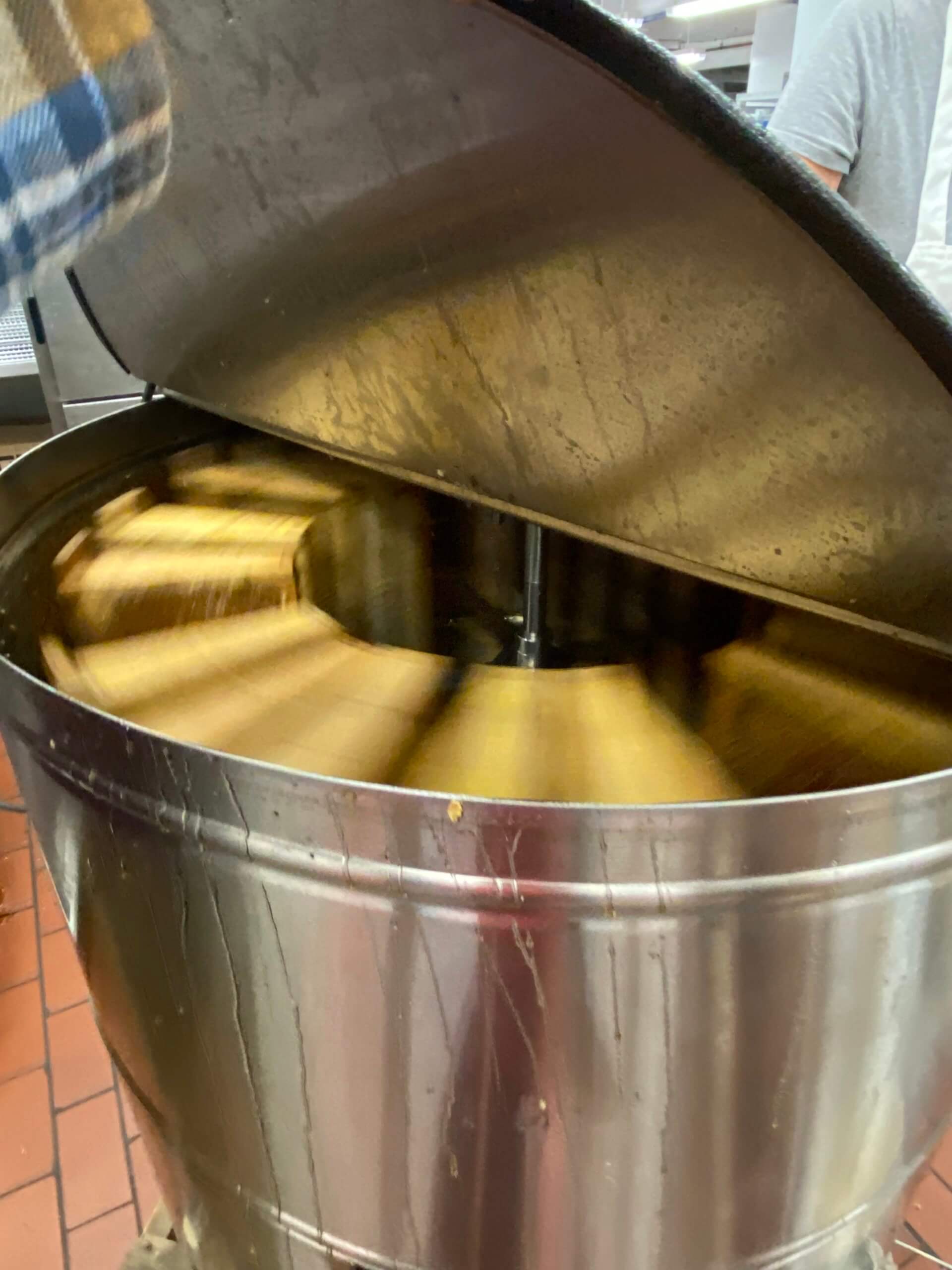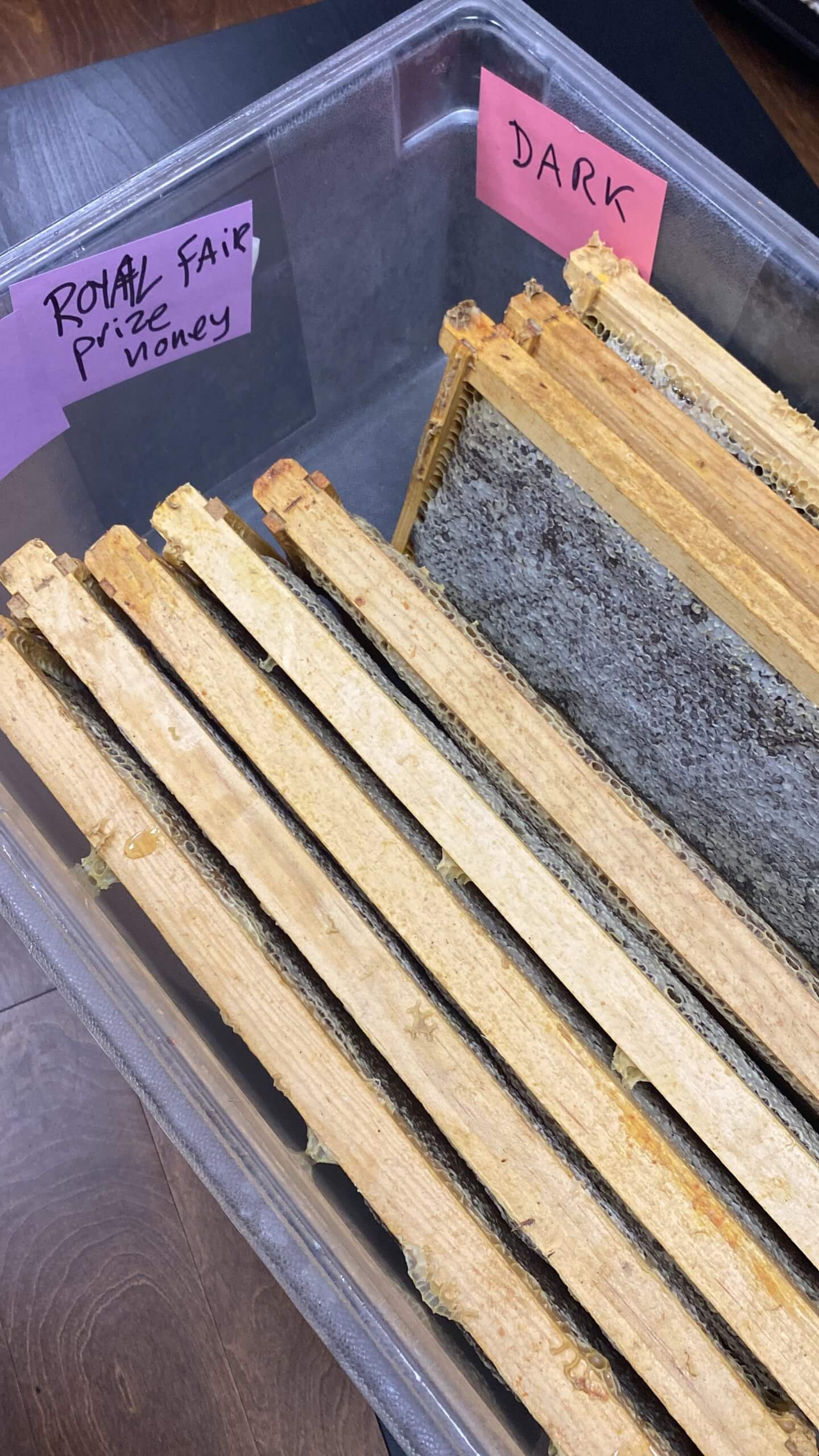Sweet As Honey: Urban Beekeeping in Toronto
If you’ve travelled to any big city around the world in the last decade or so, you may have noticed a trend towards rooftop beekeeping in hotels. Luxury hotel brands from London to Sydney have added apiaries and bee hotels to rooftops and are using the honey in items served in their restaurants.
The trend actually has a Canadian origin as Toronto’s Fairmont Royal York was the first hotel in the world to introduce a rooftop apiary back in 2008. Landsby visited the hotel during their annual honey harvest in late September to find out more about their busy residents.
Luc Peters, head beekeeper at the Toronto Beekeepers Collective, lights a bee smoker (a device used to produce, well, smoke) before bringing over a frame full of honeybees at the Fairmont Royal York annual honey harvest. The smoke works to calm and relax the bees, a technique that’s been used by humans for generations.
The bees seem happy enough to hang out in the late September sun as we watch them crawl over the honeycomb and the wooden frame.
We are sitting on the roof at the 14th floor of the iconic Royal York hotel in downtown Toronto with a terrific view of the CN Tower. Behind us is the apiary, which has six hives and, during peak season, is home to half a million honey bees. Over the years, the hives have been given cute names, such as the Royal Sweet, the Honey Moon Suite, and the V.I Bee Suite, and have been lovingly cared for by not only the culinary staff of the hotel but also by the Fairmont Royal York head beekeeper and spokesperson Melanie Coates and partner members of the Toronto Beekeepers Collective.
There is also a bee hotel on the roof, which serves as a safe haven for any wild bees that find their way here. Next to the bees is the culinary garden, which is planted every year in May and has 45 varieties of herbs, fruits and vegetables — all of which are used in the menus of the hotel’s various dining venues.
The secret life of honey bees
Much like a human’s typical day of work, foraging bees also leave the hive in the morning and return at night. And while I thought these rooftop bees were primarily foraging on the rooftop garden, head beekeeper Melanie Coates tells me that is not so.
“They will go out up to five kilometres,” she says.
So the Royal York worker bees can be found foraging for pollen and nectar in city parks and on Toronto Island. Melanie says that the flavour profile of honey is strongly influenced by what bees forage on as well as what time of year the honey is collected. And much like wine or coffee, the terroir influences honey’s taste.
“You can definitely pair honey to certain things,” she says.
“For example yogurt, you don’t want to overpower with a dark honey like buckwheat, which is a very typical Canadian late harvest honey. But a strong cheddar would be nice with a dark honey. And brie would be nice with a light honey. There’s different pairings. And I really like a little bit of honey on some prosciutto.”
You can tell by her passionate dialogue on all things honey that Melanie is heavily invested in urban beekeeping. In fact, she was one of the key people responsible for launching the Fairmont rooftop garden and bee program at the Royal York back in 2008, along with then Executive Chef David Garcelon (who now heads the kitchens at the Fairmont Banff Springs hotel).
What does it take to harvest honey?
Down in the kitchens, volunteers are hard at work extracting honey from all of the frames that have been collected.
Inside the frames are the honeycombs, which are composed of individual hexagon cells filled with honey and sealed with beeswax. That seal is called capping and it has to be gently removed before honey can be extracted. If any of the frames are pulled out and have not been capped by the bees, it means that the honey inside contains a higher water content and those frames are set aside. It is the perfect stuff to turn into mead, a type of fermented honey alcohol.
Alessandra Arciero, another amazing volunteer from the Toronto Beekeepers Collective, invites me to taste fresh honeycomb. She breaks off a piece and hands it to me.
“It tastes like the sun,” she says. I have to agree with her. Sticky and sweet, fresh honeycomb is a real treat. It is completely edible but many people choose to discard the waxy part of the comb once they have finished sucking out all the delicious golden honey.
Once the honey is uncapped, it is placed into an extractor which spins the frames very quickly removing the honey from within the combs. The honey drips down out of a spout at the bottom.
“It is sticky, messy and a lot of fun.” Alessandra says.
Annually, the bees produce about 450 pounds of honey, although that number is higher in some years. The year 2012 holds the current record of an incredible 870 lbs of honey. Every part of the collection is used — the honey, the wax and even the propolis, which is a glue-like substance bees produce and use as a way to seal cracks in the hive and keep it sanitary. People use it for its antiseptic and anti-fungal properties.

The extractor spins around quickly and forces the honey from the combs. Honey comes out from a spout at the bottom and is filtered into a bucket.
Honey and sustainability at the Royal York
Now that I had visited the bees and tasted their fresh honey, I made my way over to Executive Chef JW Foster’s office to find out how the harvest will be used in the kitchens.
“Everyone always thinks we started the program so we could have honey for the hotel,” he says. “But if that was the case we would need like 40 hives up there.”
Indeed Chef Foster oversees a huge kitchen — like three 747 airplanes stacked on top of each other, he tells me jokingly — that feeds thousands of people each day. Even in large harvest years, the honey produced on the rooftop is not nearly enough to supply all of the hotel’s dining venues. The hotel works with a local honey producer to source the rest of its honey needs.
So why bother?
“The reason they were put up there, and the reason they are there today, is for awareness,” he says, referring to the worldwide issue of declining pollinator populations. “To showcase and to get people to understand that two-thirds of everything we eat is because of honeybees.
As a chef, I believe that with everything we eat, we should be thinking about our footprint and to me the bees are extremely important to that.”
Chef Foster uses the honey in strategic ways throughout his menu so as to draw attention to it and start conversations about the importance of pollinator health. He likes to put it into the afternoon tea menu because, as he says, ‘afternoon tea and honey just go together.’
“In Reign, we might use it in one vinaigrette so we can showcase it and talk about it, keep the awareness alive,” he says. “We do a lot of stuff sweet-wise with it more than savoury. We do soak it into a cloth-rind cheddar from Ontario. We will soak it into the cheese and then torch it. Just a little taste. We also make our own crunch. We call it honey crunch, which is almost like a crunch chocolate bar. So we take honeycomb and then we coat it in really good quality chocolate.”
The bees are part of a much larger commitment Fairmont is making to sustainability, the chef tells me. Before the covid pandemic, he was using the rooftop garden to showcase the hotel’s relationships with local farmers. Seeds and plants from all the different suppliers were planted up there as a way to draw the public’s attention to the important work that all the surrounding farms do to supply city restaurants with quality produce.
“Covid messed that up a little bit because a lot of places were struggling with shortages,” he said. “But next year we will get back to that because it is important to us.”
With such a large hotel, I ask Chef Foster if it is easy or even feasible to source local and sustainable products.
“It’s not that hard actually,” he says. “It just requires a focus and dedication to push for it.”
As I speak further with Chef Foster about the joy he finds in making connections with local farmers and producers, I am reminded of my conversation with Chef Marie-Chantal Lepage from Québec City’s Hilton hotel (you can read that story here). She too talked about the importance for chefs to be connected to the people who are growing the produce.
“I get phone calls from small farmers or ranchers in Ontario that want me to buy their products. They may be selling to small high-end restaurants in the city, but when they find out we are doing the same programming, it opens the door,” Chef Foster says. “They think of us as this big machine, this big hotel downtown, whereas I can support a small farm in one restaurant. Maybe I won’t use the lamb in every restaurant because they only have so much to give and we want to make sure we are respecting the animal and using everything. But maybe we will just use it in Reign or maybe we will use this part and this part in Reign and this part somewhere else so we are using the entire product of whatever it is.”
Also close to Chef Fosters heart is using sustainable fisheries. He is part of the OceanWise program and sources a lot of product from Fogo Island which he likes to do not only because of the quality and sustainability of the product but also because it supports a small Canadian fishing community.
“That’s the stories we want our guests to hear, we need our guests to hear and support.”
Below are a few more photos from my time at the honey harvest:

Luc Peters is head beekeeper at the Toronto Beekeepers Collective and takes care of the bees on the rooftop of the Fairmont Royal York. Here he is holding one of the frames full of hundreds of bees. On the table is the bee smoker used to make smoke that keeps the bees calm and relaxed.

Honey combs set aside in Chef Foster’s office that will go for judging at this year’s Royal Agricultural Winter Fair in Toronto.

Alessandra showing off the beautiful honeycombs that have been uncapped by volunteers and are about to go into the extractor

Chef Foster shows off the huge Queen Bee Cake one of his staff members made for an event. It is completely edible and the iridescent wings are made of gelatin.
A previous version of this story mistakenly identified Luc Peters as a volunteer. He is in fact the Head Beekeeper of the Toronto Beekeepers Collective, a partner organization of the Fairmont Royal York. We apologize for the error.



















